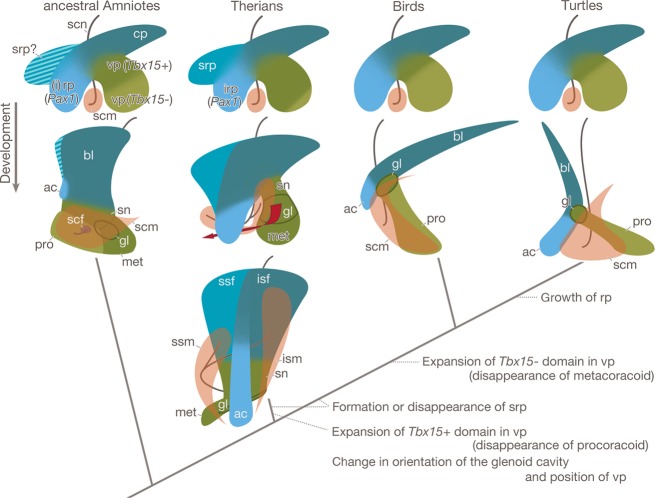Fig. 4.
Evolutionary scenario of the shoulder girdle. The girdle primordium in the ancestral amniotes would have been situated dorsal to the anlagen of the supracoracoid muscle and nerve, and would have had at least three projections. The caudal process would have formed the scapular blade. The rostral process would have expressed Pax1 and would have formed the acromion. The ventral process would have been divided into a dorsolaterally situated Tbx 15-positive domain and a ventromedially Tbx15-negative domain, of which the former would have grown into the metacoracoid, scapular neck, and glenoid cavity, and the latter into the procoracoid. This pattern of the girdle anlage is conserved in extant therian mammals and saurians, although the relative size of the Tbx 15 domain in the ventral process differs between the animals, and the therian mammals have a suprarostral process. In the therian mammals, the suprarostral process forms the rostral half of the scapular blade, the supraspinatus fossa, and the caudal process forms the caudal half of the blade, the infraspinatus fossa. The presence or absence of the suprarostral process in the ancestral amniotes is uncertain (striped area), thus the process and its derivative may have been invented in the lineage leading to the therian mammals or may have been lost during the evolution of saurians. In therians, the Tbx 15-negative domain becomes a lesser part of the ventral process and the process forms the glenoid cavity, scapular neck, and the metacoracoid. These ventral process derivatives changed their orientation and position during later development (red arrow), which was accompanied by a division and rostral shift of the anlagen of the supracoracoid muscle and nerve to form the supraspinatus muscle and suprascapular nerve, respectively. In the saurians, the Tbx 15-positive domain became a lesser part of the ventral process and formed only the glenoid cavity, while the Tbx 15-negative domain formed the procoracoid. In the lineage leading to turtles, the growth of the rostral process would have been promoted to form the large acromion.

